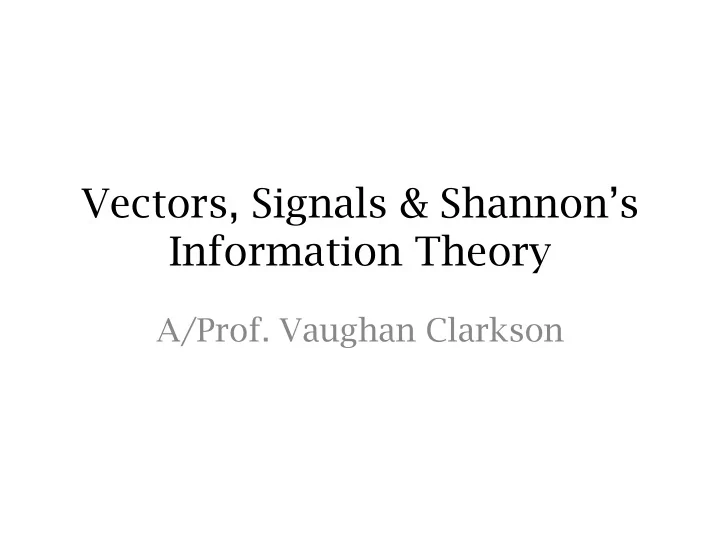

Vectors, Signals & Shannon’s Information Theory A/Prof. Vaughan Clarkson
10 PROCEEDINGS OF THE I.R.E. January through the attenuator to the receiver. In this manner, space-charge type illustrated in Fig. 5. The shape of this the gain versus the cathode-potential-difference curve of curve corresponds rather closely with the shape of the Fig. 17 was obtained. This figure corresponds rather theoretical curve given in Fig. 7. Fig. 8 shows the output closely with the theoretical curve of propagation con- voltage versus drift-potential characteristic for the two- stant versus the inhomogeneity factor, shown in Fig. 1. velocity-type electron-wave tube. When the drift-tube voltage is high, the tube behaves like the two-cavity klystron amplifier. As the drift voltage is lowered the gain gradually increases, due to the space-charge inter- action effect, and achieves a maximum which is ap- proximately 60 db higher than the output achieved with 40 - - - I, I,- 15.ma. klystron operation. With further reduction of the drift- 30c1 X2 238.volts tube potential the output drops rather rapidly, because -2 the space-charge conditions become unfavorable; that is, - 3000 me. 20fC the inhomogeneity factor becomes too large. The electronic bandwidth was measured by measur- -_ lo ing the gain of the tube over a frequency range from 2000 to 3000 Mc and retuning the input and output cir- cuits for each frequency. It was observed that the gain of the tube was essentially constant over this frequency range, thus confirming the theoretical prediction of -20 electronic bandwidth of over 30 per cent at the gain of 80 db. The electron-wave tube, because of its remarkable CATHODE POTENTIAL DIFFERENCE (V -V2) I~ V L 10 o 20 30 40 so 60 70 80 90 100 110 §20 property of achieving energy amplification without the Fig. 17-Gain versus cathode-potential-difference characteristics use of any resonant or waveguiding structures in the of the two-velocity-type electron-wave tube. amplifying region of the tube, promises to offer a satis- factory solution to the problem of generation and At a frequency of 3000 Mc and a total current of 15 ma, amplification of energy at millimeter wavelengths, and a net gain of 46 db was obtained, even though no at- thus will aid in expediting the exploitation of that por- tempt was made to match either the input or output tion of the electromagnetic spectrum. circuits. The lack of appropriate match is responsible ACKNOWLEDGMENT for the fact that the gain curve assumes negative values when the electronic gain is not sufficient to overcome the The author wishes to express his appreciation of the losses due to mismatch. At the peak of the curve, it is enthusiastic support of all his co-workers at the Naval estimated that the electronic gain is of the order of 80 Research Laboratory who helped to carry out this proj- db. ect from the stage of conception to the production and The curves of output voltage versus the potential of tests of experimental electron-wave tubes. The untiring the drift tube were shown in Figs. 8 and 9. Fig. 9 shows efforts of two of the author's assistants, C. B. Smith this characteristic for the electron-wave tube of the and R. S. Ware, are particularly appreciated. Communication in the Presence of Noise* CLAUDE E. SHANNONt, MEMBER, IRE Summary-A method is developed for representing any com- I. INTRODUCTION munication system geometrically. Messages and the corresponding signals are points in two "function spaces," and the modulation A GENERAL COMMUNICATIONS is system process is a mapping of one space into the other. Using this repre- shown schematically in Fig. 1. It consists essen- sentation, a number of results in communication theory are deduced tially of five elements. concerning expansion and compression of bandwidth and the 1. An information source. The source selects one mes- threshold effect. Formulas are found for the maxmum rate of trans- mission of binary digits over a system when the signal is perturbed sage from a set of possible messages to be transmitted to by various types of noise. Some of the properties of "ideal" systems the receiving terminal. The message may be of various which transmit at this maxmum rate are discussed. The equivalent types; for example, a sequence of letters or numbers, as number of binary digits per second for certain information sources in telegraphy or teletype, or a continuous function of is calculated. timef(t), as in radio or telephony. * Decimal classification: 621.38. Original manuscript received by 2. The transmitter. This operates on the message in the Institute, July 23, 1940. Presented, 1948 IRE National Conven- tion, New York, N. Y., March 24, 1948; and IRE New York Section, some way and produces a signal suitable for transmis- New York, N. Y., November 12, 1947. sion to the receiving point over the channel. In teleph- t Bell Telephone Laboratories, Murray Hill, N. J. Shannon’s Information Theory In the late 1940s, Claude Shannon published a series of papers which introduced his information theory . • It revolutionised communications systems.
Bandlimited Signals A signal is just a function of time x ( t ) • – But it has some physical significance, e.g. , a voltage waveform A bandlimited signal is one where the frequency components • lie between a minimum and maximum frequency – We can force a signal to be bandlimited by passing it through a filter
Recommend
More recommend